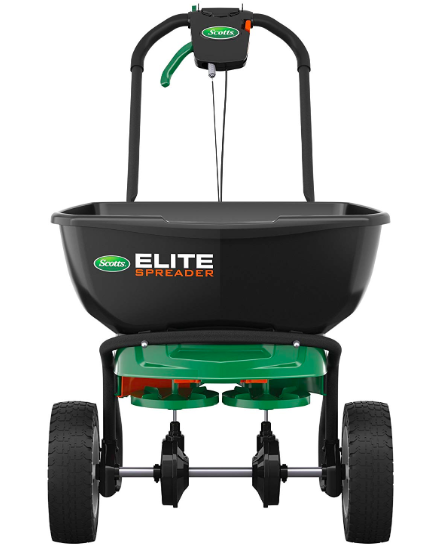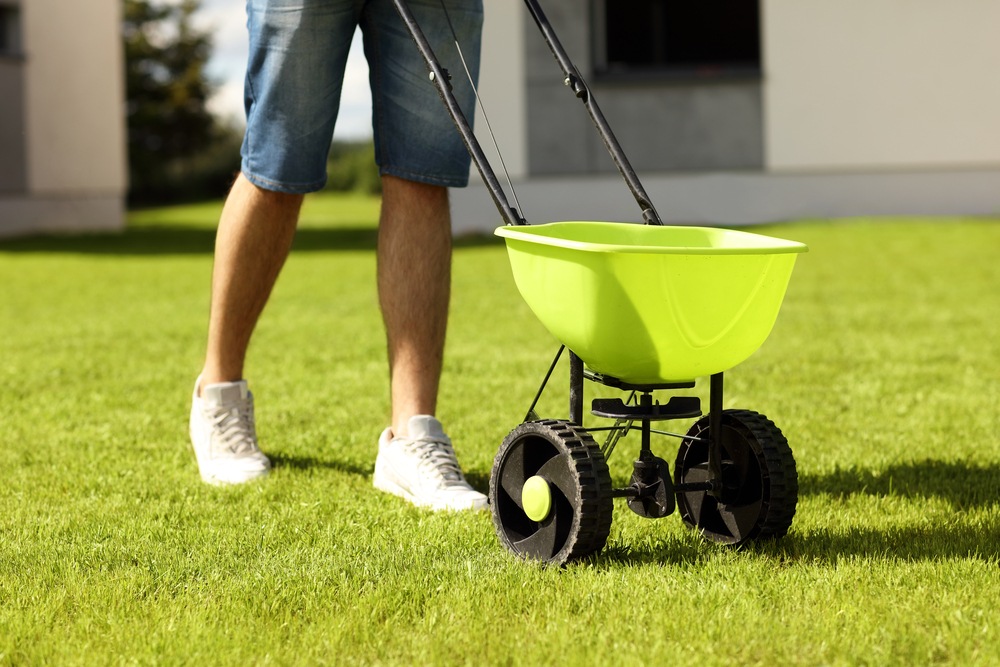Fertilizer application needn’t doing manually. Depending on the size of your property, using only your hands can take a lot of time and effort. Thus, it’s a more practical decision to use a fertilizer spreader. There are many of them available in the market, but we’ll help you find the best fertilizer spreader for your lawn with our comprehensive guide.
Top 7 Best Fertilizer Spreaders For Your Lawn This 2023
Image | Product | Our Rating | Price |
|---|---|---|---|
 | $$ | ||
 | $$$ | ||
 | $$$ | ||
 | $$ | ||
 | $ | ||
 | $$$ | ||
 | $ |
Top 7 Fertilizer Spreader Reviews
Agri-Fab 45-0463 130-Pound Tow Behind Broadcast Spreader
The first fertilizer spreader we have has a three-year warranty, and three optional parts: hopper grate, hopper cover, and material deflector. All of these options are designed to improve the overall performance of the Agri-Fab 45-0463 Broadcast Spreader.
First, the hopper grates prevent any clumps from affecting the flow control opening. Next, the hopper cover protects the granular products from being spilled due to harsh winds or bumps during operations.
As for the material deflector, it mitigates the scattering of the product over walkways, driveways, and other unwanted section to reduce waste.

Via amazon.com
What We Liked
- Both the spreader plate and the poly hopper have proven to be rustproof with extensive use.
- Rugged beveled gear due to its aluminum construction.
- Does not fall over when running in slopes and hills.
- Stable even on rough terrain since the wheels are 13 inches in diameter and 4-inch wide.
- Assembling the spreader takes just about an hour.
- The release bar can be conveniently reached even if you are sitting on your lawn tractor.
What We Didn't Liked
- The spring keeping the handle in place seems weak.
- The plastic located on the gear housing cover can be easily separated since it is only attached with two pins.
- The shape of the container is not good for letting out all of the fertilizer down to the bottom.
Earthway 2150 Commercial 50-Pound Walk-Behind Broadcast Spreader
Next, we have the Earthway 2150 Commercial Broadcast Spreader. Its poly hopper can carry as much as 23 kilograms or 50 pounds of granular product, which should be enough to cover a decently sized area without a refill. It features a compact design that’s good for lawn owners with a limited storage space.
To improve the precision of the Earthway 2150 Commercial Broadcast Spreader, it employs what it calls the EV-N-SPRED 3-hole drop shut-off system. This system features a feathered spreading edge for a more accurate coverage. Likewise, there’s an adjustable handle and a T-Speed level for user convenience regardless of the operator's height.

Via amazon.com
What We Liked
- Coverage is wide yet fairly accurate.
- Large carrying capacity does save time by eliminating the need for refills.
- The frame of the load capacity feels rugged.
- A chart is included to help the user know how to use product to achieve the best coverage.
What We Didn't Liked
- Needs a sweeper design with a steep angle so that no amount of the fertilizer will remain.
- Instruction manual could have been better written, especially with regard to the bolt lines and attaching the bar to the trap door.
- The tire loses some air due to the plastic rims, leading to uneven movement.
Scotts Turf Builder EdgeGuard Deluxe Broadcast Spreader
This broadcast spreader is used in the seasons of spring, summer, and fall. The hopper of the Scotts Turf Builder EdgeGuard Deluxe Broadcast Spreader can accommodate up to 15,000 square feet of lawn care products. We didn’t have to spend so much time upon receiving it since this broadcast spreader is already pre-calibrated and ready to use upon arrival.
Additionally, the Scotts Turf Builder EdgeGuard Deluxe Broadcast Spreader has a control panel that allows you to modify the precision rate of the machine. This could improve the coverage performance. Since this is a Scotts fertilizer spreader, it has the EdgeGuard feature which covers off the right portion of the spreader pattern. This stops it from wasting the product on the non-lawn sections of your property.

Via amazon.com
What We Liked
- EdgeGuard technology helps in waste reduction.
- Control panel works in improving the spreader precision.
- The granular product is uniformly spread all over the lawn.
- Immediately reliable due to being pre-calibrated.
- Can accommodate a huge amount of lawn care products.
What We Didn't Liked
- Not exactly a large spreader but it still requires a bit of storage space.
- A small portion of the fertilizer is occasionally dropped on the inner section of the tires.
Scotts Wizz Hand-Held Spreader
Intriguingly, our fourth fertilizer spreader comes from Scotts too. It is touted as a spreader to be used all throughout the year to serve various purposes: feeding, seeding, weeding, and melting ice during the winter.
While the previous Scotts Broadcast Spreader can easily accommodate 15,000 square feet of lawn care products, this handheld-type spreader can understandably carry just up to 2,500 square of it.

Via amazon.com
Still, this battery-operated fertilizer spreader has a trick up its sleeve. Not only does this have the previously mentioned Edge Guard to reduce product waste, but it also has the Handy Lock technology. This acts as a trigger lock so that you don’t have to constantly press the Scotts Wizz Hand-Held Spreader while distributing granular products over your lawn.
What We Liked
- The convenient Handy Lock technology.
- EdgeGuard feature works well to keep the fertilizer dropping where it should.
- Controll the amount of lawn care products such as insecticide, fertilizer, and fungicide
- The granules are sprayed in a pattern that covers a distance of about six feet.
What We Didn't Liked
- Handy Lock feature does not always work, which forces us to press and release the spreader several times.
- Lacks a lid or cover for the lawn care products in case of rain.
- The battery compartment requires a screwdriver to be opened unlike other spreaders with more ergonomic designs.
Brinly BS36BH Tow Behind Broadcast Spreader
This is a broadcast spreader with a remarkable 175-pound poly hopper carrying capacity. This amount is sufficient enough to cover a one acre or more lawn. The moment we received the Brinly BS36BH Tow Behind Broadcast Spreader, it came as quite sturdy. It features stainless steel hardware, and the gearbox is fully enclosed to keep the components safe.
The Brinly BS36BH Tow Behind Broadcast Spreader has the Directional Spread Pattern Control feature. As the name implies, its coverage and spread with can be controlled and determined by the operator.

Via amazon.com
What We Liked
- Assembling is easy due to a well-made instruction manual.
- The parts are sturdy and they came both labeled and secured in blister packs.
- The spring tension located at the bottom of the hopper stops it from getting clogged.
- Design of the bin ensures a nice flow and no amount of the granular product will remain.
What We Didn't Liked
- Distribution lever tends to slip and accidentally let out more fertilizer than needed.
- Stem connecting to a tow vehicle should be adjustable to accommodate users of varying heights.
Scotts Elite Spreader , 20m - 75902
This is another broadcast spreader from Scotts. In terms of the similarities, the Scotts Elite Spreader has a control panel for modifying the precision rate, and it also comes in pre-calibrated and ready to be operated from the get-go. As we expected from its name, it features the EdgeGuard technology to stop the fertilizer from being scattered over non-lawn sections.
What makes it different from the first two reviewed Scotts fertilizer spreaders is the ability to accommodate up to 18,000 square feet of lawn care products. Furthermore, the air-filled pneumatic tires of this spreader have been designed for better movement on different types of terrain.

Via amazon.com
What We Liked
- Can move along slopes and hills without a hitch.
- Premium pneumatic tires conveniently push the spreader forward.
- Fairly easy to operate.
- Putting all of the fertilizer in the open bin isn’t difficult and there are no spills.
What We Didn't Liked
- Handle should be adjustable by around five inches so tall people won’t have a hard time using it.
- No conversation chart is included to help determine the products and the amount to use.
Scotts Easy Hand-Held Broadcast Spreader
Finally, we have another guy from Scotts. This is made for small-sized lawns, and it comes fully assembled for immediate use. Whether it’s for seed planting or herbicide application, the Scotts Easy Hand-Held Broadcast Spreader is designed for usage throughout the year.
During winter, this is light enough to be carried and get rid of the accumulated snow on the pavement through the use of ice-melting products. Consequently, this broadcast spreader is rustproof and capable of carrying a maximum of 1,000 square feet of lawn care products.

Via amazon.com
What We Liked
- Crank surprisingly seems durable despite being made of plastic.
- Products are uniformly spread especially with the help of the distributor mechanism.
- Easy to store in the garage due to its size.
What We Didn't Liked
- Some of the pellets tend to get stuck on the bottom section of the spreader.
- The crank is not convenient for left-handed operators.
- It can get tiring to use the crank all the time.
Why Use A Fertilizer Spreader
A fertilizer spreader is meant to apply granular products over your lawn in an even manner. Why is it important to have a uniform fertilizer application? Well, unevenly laid down fertilizer can increase the risk of weed invasion, plant disease, and pest invasion.
Moreover, your plants will have differences in growth rates due to the uneven amount of nutrients they will receive. Not only can there be color variations among your plants but also distinctions based on root strength. Likewise, your lawn needs a sufficient amount of the active ingredients for the best growth speed. While summer and fall are the best periods to apply fertilizer, you also need to apply it during the winter to fortify your lawn against the harsh cold elements.
On a related note, a fertilizer spreader is not limited to fertilizer application. In fact, you can also use it to evenly distribute grass seeds and to manage ice melt located on pavements.
Different Types Of Fertilizer Spreaders
Before buying yourself a fertilizer spreader, you first consider the three types available. Being aware of their functions and compatibility with your property will help you save money – or at least allow you to spend it wisely.
Handheld Fertilizer Spreader
This is unarguably the simplest type of fertilizer spreader. It’s light enough to carry with only one hand. Once you decide to use it on your lawn, your other hand can take care of the grinding process.
As you might have already expected, a handheld spreader is designed for relatively small properties. It can speed up the fertilizer coverage even if you are using your hands. While it has a small capacity compared to the other types, it’s affordable, convenient, and suitable for those with small gardens to tend to.
Push Fertilizer Spreader
Also known as a walk-behind fertilizer spreader, this type of fertilizer spreader has wheels for faster movement. Thus, you wouldn’t have to get a vehicle to carry out your fertilizer coverage operations. With each wheel rotation, the push fertilizer spreader will also release the granular product. While this will still require some physical effort, this type of spreader is recommended for owners of medium-sized or even slightly large-sized lawns.
Tow-Behind Spreader
The third type of fertilizer spreaders is the tow-behind spreader, which is similar to the push fertilizer spreader since it is also a wheeled variant. Similarly, the spreading mechanism is activated once the wheels begin to turn.
One significant difference, however, is that the tow-behind fertilizer spreader has a large carrying capacity that makes it ideal for huge tracts of land. Furthermore, as the name implies, one need not push this spreader. Instead, it is meant to be pulled along a mower or an all-terrain vehicle (ATV). In addition, some two-behind spreader models have an aerating attachment, which allows you to accomplish two lawn maintenance tasks.
If you are looking for the best electric lawn mower, you can refer my post:
/best-cordless-lawn-mower-reviews/
Differences In Application Method
Aside from learning the differences among the handheld, pull, and tow-behind fertilizer spreaders, you must also know what you want in terms of precision. In this aspect, you should be able to distinguish a drop spreader from a broadcast spreader. Both of them have their advantages and disadvantages, so let’s read up on them.

Drop Spreader
The main advantage of a drop spreader over the broadcast spreader is its precision. The application method here is dropping the product between the wheels of the machine. Thus, you can accurately manage where the fertilizer or herbicide is bound to fall over your lawn.
Consequently, the drop spreader is the ideal choice if you have a medium-sized property that utilizes garden rows. As the spreader moves in a straight path, the fertilizer or the grass seed is dropped down your lawn at a precise width. To ensure the even distribution, the wheels of the drop spreader need to overlap. Using this machine, you will easily know which parts of your lawn have been treated with the lawn care product.
Still, one disadvantage of this is its relatively small coverage due to the pattern it uses. If you need accurate product distribution for garden beds and rows, you are likely to make several passes to cover the entire property. In addition, you have to be careful when you use this spreader. If you drop too much of the product, the grass could burn or at least leave stripes. Misaligned passes could also leave some of your areas with insufficient fertilizer.
Broadcast Spreader
In contrast, this fertilizer spreader works by releasing the product on both the front area and the side sections of the machine using a spinning disc. The rotary mechanism typically has a spread radius ranging from three feet to four feet. Thus, it significantly has a bigger coverage area than a drop fertilizer spreader. If you want to cover a large or commercial property as fast as possible, this is what you should get.
While it does its job quickly, it cannot compete with a drop spreader in terms of precision. There are broadcast spreaders that feature a guard for usage even at the edge and corners of your property. Butt its mechanism can quickly lead to scattered products in unwanted areas such as on the pavement and on someone else’s lawn.
Additionally, you would have to pass over the same area if the spread distance is far from the broadcast spreader. If you don’t, the granular product might not be spread in a uniform manner.
Best Fertilizer Spreader - Winner
In the end, our favorite fertilizer spreader is none other than the Scotts Turf Builder EdgeGuard Deluxe Broadcast Spreader.
Its hopper can hold up to 15,000 square feet of lawn care products, and it is an all-year spreader.
Thus, you don’t have to buy anything else if you need to spread grass seeds, apply herbicide, or conduct some ice-melting operations.
Despite being a broadcast spreader, we can still have accurate distribution due to the adjustable precision settings. Plus, it’s pre-calibrated and does not waste any of the granular products thanks to the EdgeGuard technology.

Via amazon.com
Conclusion
We hope that our guide helped you in making the right buying decision. A fertilizer spreader is a great tool to keep your lawn in top shape. If you have any queries, feel free to give us a comment.
FAQ
1. Common fertilizer spreader problems?
- When using a broadcast spreader, you must walk at exactly the same pace throughout the entire yard to always have an even spread
- Drop spreader usually offer less accurate control over how much materials is dropped
- Drop spreader takes a longer time to spread product, so it usually use in a small space.
2. How to use fertilizer spreader the right way?
- The lawn should be mowed before fertilizing
- Make sure that your fertilizer spreader dry
- Follow the manufacturer's specifications
- Keep the the spreader hopper close before adding product.
- Walk at a steady pace.
- Clean your fertilizer spreader after each use.

